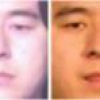Free Online Productivity Tools
i2Speak
i2Symbol
i2OCR
iTex2Img
iWeb2Print
iWeb2Shot
i2Type
iPdf2Split
iPdf2Merge
i2Bopomofo
i2Arabic
i2Style
i2Image
i2PDF
iLatex2Rtf
Sci2ools
ICIP
2009
IEEE
2009
IEEE
Asymmetric 3d/2d Face Recognition Based On Lbp Facial Representation And Canonical Correlation Analysis
In the recent years, 3D Face recognition has emerged as a major solution to deal with the unsolved issues for reliable 2D face recognition, i.e. lighting condition and viewpoint variations. However, 3D method is currently limited by its registration and computation cost. In this paper, we propose to investigate a solution named asymmetric face recognition scheme, enrolling people in 3D environment but performing authentication in 2D. The goal is to limit the use of 3D data to where it really helps to improve recognition performances. In our approach, Local Binary Patterns (LBP) is used as an efficient facial representation for both 2D texture and 3D range images. A weighted Chi square distance is computed as matching score between 2D LBP facial representations; Canonical Correlation Analysis (CCA) is applied to learn the mapping between the LBP-based range face images (3D) and LBP facial texture images (2D). Both matching scores are further fused to obtain the final result. Compared w...
Asymmetric Face Recognition | Face Recognition Scheme | Face Recognition Solution | ICIP 2009 | Image Processing |
| Added | 10 Nov 2009 |
| Updated | 26 Dec 2009 |
| Type | Conference |
| Year | 2009 |
| Where | ICIP |
Comments (0)

